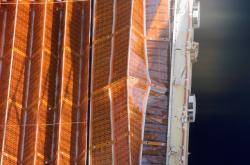Shuttle astronauts spent a frustrating day today, trying to get the International Space Station’s solar wings retracted. NASA was hoping to retract the wings fully to allow new permanent solar panels to rotate to face the Sun and begin generating electricity. Astronauts did get the wings partially retracted; far enough to allow the larger wings to rotate, so NASA is considering the day a success. A spacewalk might be scheduled later in the week, for astronauts to manually assist folding the array.
The International Space Station’s newest set of solar arrays is tracking the sun tonight, following partial retraction of a similar array that’s been the station’s primary power plant for six years. This event sets the stage for two challenging spacewalks by the STS-116 crew to rewire and reroute the station’s power system.
The Solar Alpha Rotary Joint (SARJ) and the new set of arrays are a part of the P3/ P4 truss segments that were installed onto the station in September during the STS-115 mission. The rotary joint enables the solar arrays to follow the sun and generate the maximum power possible. Activation of the SARJ occurred shortly before 8 p.m. EST, and a few minutes later the Mission Control Center in Houston notified the crew that the arrays were following the sun.
Throughout the day, the STS-116 crew and flight controllers worked together to solve problems that prevented the P6 truss port solar arrays from folding properly. The retraction activities of the arrays began at 1:28 p.m. More than 40 commands were sent to furl and unfurl the arrays in an attempt to properly align them. When the efforts concluded about 7:50 p.m., 13.5 of 31 bays had been folded, leaving the port arrays in a safe position that allowed the activation of the P4 rotary joint.
The crew also received word that Thursday’s spacewalk will take place as planned despite the problems retracting the P6 solar array. Mission Specialists Bob Curbeam and Christer Fuglesang, who conducted the mission’s first spacewalk, are scheduled to begin Thursday’s orbital stroll at 3:12 p.m. They will begin efforts to rewire the station, bringing power generated by the P4 arrays on line for use by the station’s systems and prepare for more arrays to be added next year.
In preparation for the spacewalk, Curbeam and Fuglesang will again “campout” in the station’s airlock. The pressure will be lowered in the airlock to the pressure normally found on Earth 10,000 feet above sea level during the overnight campout. The procedure protects against decompression sickness as Curbeam and Fuglesang go to the even lower pressure of spacesuits on Thursday.
Original Source: NASA Status Report
